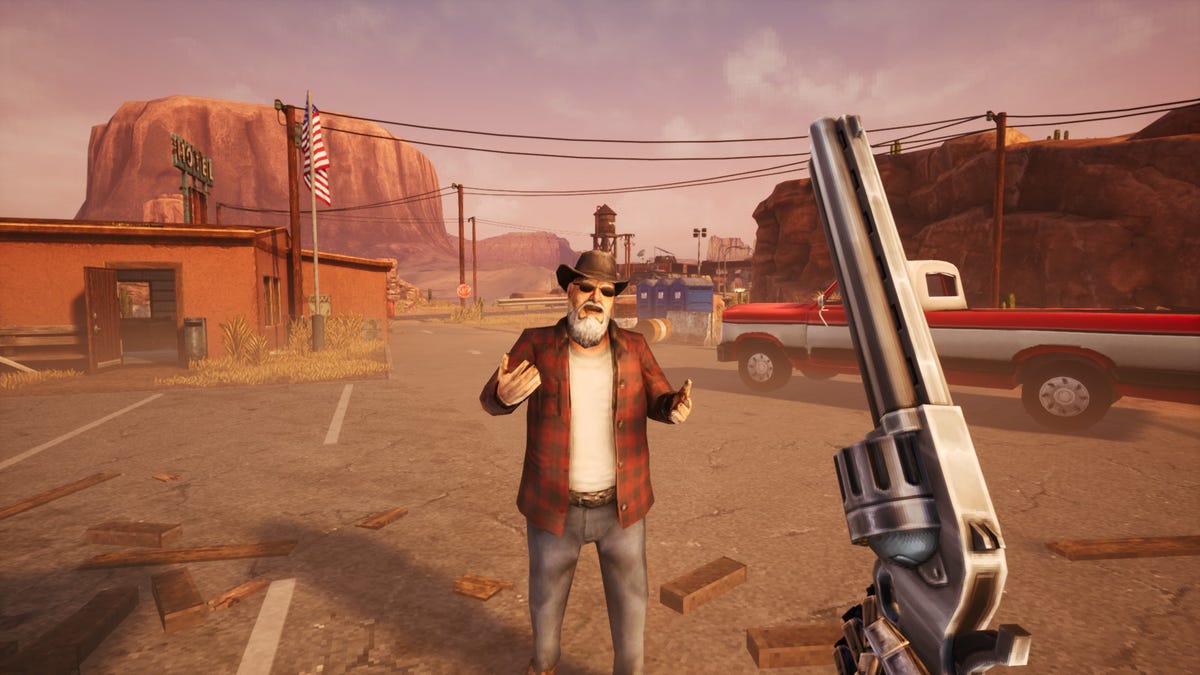Tech
New Retro Shooter Mashes Duke Nukem And Half-Life Together

Shelly “Bombshell” Harrison, along with her robotic arm and famous three-barrel revolver, is back in Phantom Fury, a new FPS boomer shooter adventure set after the events of 2021’s Ion Fury and its expansion.
Where retro shooter Ion Fury was directly inspired by Duke Nukem 3D and its 2.5D Doom-like visuals, Phantom Fury moves ahead in video game history and is an homage to late ‘90s and early 2000s FPS games, like Sin, Half-Life 2, Serious Sam, and No One Lives Forever. That means the game is fully 3D, and contains bigger levels, physics, vehicle sections, and even RPG-like upgrades. And all of this mostly works, though some bugs and design choices muck things up.
Set after the events of Ion Fury—don’t worry you don’t need to play that game to understand what’s happening here—Phantom Fury kicks off with its main character, Shelly, waking up from a coma. Quickly, she grabs a weapon and fights her way out of an underground facility. She then goes on a mission to save the entire world from lunatics bent on getting their hands on a very powerful weapon. You know, standard video game stuff. While Phantom Fury’s narrative is mostly threadbare, it’s fine because these kinds of “retro boomer shooters” are at their best when people are shooting, not talking.
Thankfully, for the most part, the combat in Phantom Fury is very good, with guns feeling heavy, loud, and dangerous. Even the starting pistol you get is a solid workhorse that can take down enemies quickly if you pull off headshots. Later guns, like Shelly’s iconic Loverboy revolver, are even better, offering up alt-fire modes and upgrades that shift how you use each weapon.
When I previously played an early demo of Phantom Fury, I was disappointed by how bullet-spongey enemies felt and how the gunplay didn’t feel snappy or punchy enough. I’m happy to report those problems are mostly solved, though I still feel like a few bigger enemies you encounter occasionally take a bit too much damage to drop. Still, 90% of the time I was having a blast running around Phantom Fury’s retro-inspired levels killing soldiers, robots, and zombies alike.
Playing pinball and breaking TVs in Phantom Fury
These retro-shooter combat sections are often broken up by puzzles, mini-games, and exploration. You might have to search a seedy bar to find the way forward or use a crane to move some boxes and create a path to the next area. These can sometimes be annoying, especially when the crane bugs out, but I do appreciate how much of Phantom Fury’s world can be interacted with and modified. Nothing feels static.
Nearly every item—from random bottles, boxes, stacks of paper, and TVs—can be grabbed, turned off, smashed, or shoved around. If you are someone who loves messing with every interactable object in Duke Nukem 3D, you’ll get lost in certain Phantom Fury levels that contain working arcade machines, pinball tables, computer terminals, crane games, toilets, light switches, and projectors. Exploring the game is a treat, even when you aren’t shooting shit or solving puzzles. It also helps that Phantom Fury and its 15+ levels contain some wonderfully retro aesthetics.
Unlike Ion Fury, Phantom Fury is more inspired by early ‘00s PC shooters and PS1/N64 aesthetics. So instead of crude 2.5D buildings and sprites, the world is built out of pixelated textures and lower-poly but full 3D models, geometry, and baddies.
The best way to describe Phantom Fury’s visuals is that everything looks like how you remember games from 2001 looking—it’s the game your mind conjures up before you actually boot up your favorite early 3D shooter and discover that it was much uglier than you remember. This visual style works well and, more importantly, feels cohesive. Everything from menus, to characters, to weapons, and level details feel like one unified vision. And this simplified, low-poly style helps you easily discern what’s happening during large combat sections, too.
Performance issues and annoying bugs
Unfortunately, I ran into performance issues while playing Phantom Fury. Tweaking visual settings helped curb some of the frame rate drops I ran into, but I couldn’t completely smooth things out. I also experienced one too many bugs, including missing graphical elements, UI issues, enemies getting stuck in walls, and other mildly annoying problems that could usually be solved with a reload or restart. None of these issues made Phantom Fury unplayable, but they did sour my time with it.
On the other hand, the performance issues and bugs reminded me of when I would try to play old-school shooters on my crappy Walmart PC back in the day, which did add to the retro-shooter vibes, I guess.
Phantom Fury is a worthy follow-up to Ion Fury, even if its opening levels are a bit dull and it suffers from more bugs and performance issues. The larger maps, intense gunplay, vehicle sections, puzzles, interactable environments, and fun-to-explore retro-3D levels more than makeup for some occasional FPS drops or weird UI bugs. And hopefully, a future patch can fix these problems and make Phantom Fury even better.
Phantom Fury launches on April 23 on PC. It will be released on consoles in the future.
.










